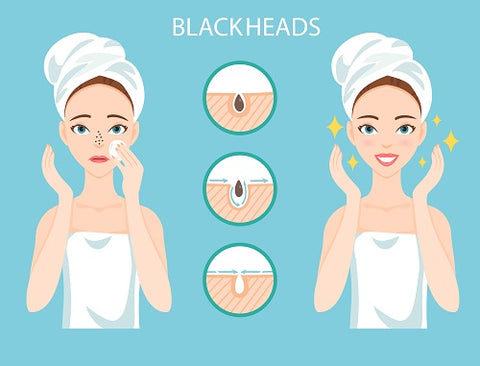To Believe or Not To: Beauty Myths
The world with all its beauty and wonder is also a strange place with myths and superstitions existing at the very core of it. Beauty myths, just like fairy tales and superstitions, have been passed down from generation to generation since time immemorial.
The world of beauty is full of lists of do’s and don’ts, should and shouldn’ts and thanks to that, we don’t know how to set apart right from wrong. The number of beauty myths floating around today is as abundant as the beauty products available in a supermarket. Everyone has their own set of grandmama’s tips, tales, and superstitions which they are more than happy to pass around irrespective of whether they make an iota of sense. But to be fair, a lot of practices handed down through generations have some reasoning behind them; it’s only that the reasoning has gotten obscured over time.

Additionally, the burgeoning beauty industry purportedly has a cure or a solution for almost all skin and hair woes and with big and small brands vying to capture market share with bizarre claims and even bizarre ingredients, it only gets worse.
The common perception is that the price of a product directly correlates to the level of its effectiveness. The more expensive a product, the more effective it may be. But this is just not true. At times, inexpensive products from a small or hereto unknown brand might do a better job than its more expensive branded counterpart. The other common misconception is that one shouldn’t mix brands. In other words, products that are part of your beauty regime should ideally belong to the same brand. Well, that is again not true.
So, what’s true and what isn’t?
Through this blog we’ve attempted to clear out some common misconceptions that unfortunately most women seem to be familiar with.
Here are 9 beauty myths and the actual truth behind them so you know exactly what to believe and what to chuck in a trash can! Read on to be better informed.

MYTH #1: Shaving Your Face or for that matter, any other part of the body will cause hair to grow back thicker and darker
The Truth: That’s one myth we’ve all heard growing up and absolutely far from the truth.
This is not true at all! In fact, shaving helps in exfoliation. It gets rid of the uppermost layer of dead skin cells and leaves you with soft, glowing skin along with creating a smooth base for any skincare or makeup routines!
NYC dermatologist, Dr. Neal Schultz, in his interview with Cosmo, says “That myth exists because people mistake the wispy feeling of their unshaven hair with the slightly blunt feeling they experience as their hair starts to grow back as ‘thicker,’ and the new, not-yet-sun-bleached hair as ‘darker.”

MYTH #2: Sun Exposure Can Help Your Skin And Reduce Acne
The Truth: Half the time when we’re out in the sun, we think it’s helping our complexion and giving us a brilliant tan. But turns out, exposure to the sun can damage your skin permanently. It might be tempting to think that the sun is giving you a healthy glow but the only thing it is doing is burning your skin and dehydrating it. It makes skin patchy and flaky, damaging it beyond repair.
This patchy layer of skin then blocks your pores, trapping sebum (oil) inside the skin cells and causes breakouts. Also, exposure to the sun can cause skin discoloration, inflammation, dark spots and premature aging thanks to the UVA and UVB rays.
Having said that, while getting in too much sun damages skin, letting in a bit is definitely a good idea. The best-known benefit of sun exposure is vitamin D synthesis which occurs due to the skin’s response to the sun’s UV rays. And we all know how critical a nutrient Vitamin D is.

MYTH #3: Toothpaste Can Treat Pimples
The Truth: We’re all guilty of trying this one, and it is the most common misconception out there that if you apply toothpaste on your pimples before sleeping, it will disappear overnight. What most people don’t know is that the fluoride in toothpaste can exacerbate acne, leading to skin peeling and irritation.
Any product not particularly meant for skin can be harmful and should be avoided. The ingredients in toothpaste work great at cleaning teeth but can be harsh on something as sensitive as your skin. In fact, a large number of women have suffered from acne spots after using toothpaste as a cure for pimples.
Safer alternative would be to opt for medications that target specific skin problems.

MYTH #4: You Can’t Use Oil On Oily Skin
The Truth: Contrary to popular belief, you can implement oil into your skincare routine even if you have oily skin. Topical oils prevent the skin from overproducing its own natural oil which in the long run is actually beneficial.
So ‘hydrate and moisturize’ shouldn’t be the motto of just people with dry skin! All types of skin require an abundance of both to retain the skin’s natural pH balance. No matter what your skin type is- dry, oily, combination or normal- it needs moisture to recharge and the only thing you need to be sure about is the type of skin you have and pick a moisturizer best suited for it.
Add a little oil to your routine and see the difference! For oily skin types, go for a moisturizer that is non-greasy and light-weight.

MYTH #5: Blackheads Can Be Scrubbed Away
Despite what many people think, blackheads are not actually related to dirt in any way. They are more like dead skin cells that block the path for the sebum (oil) produced by the hormones to get out, forming a clogged pore. As the combination of dead cells and sebum reaches closer to the uppermost layer of the skin, it oxidizes and turns black.
Scrubbing helps take away the uppermost tip of the blackhead without addressing the root cause of the problem and before you know it, they’ve appeared again.

MYTH #6: Products Labeled ‘Natural’ And ‘Chemical-Free’ Are 100% Natural And Better
The Truth: Since the beauty and makeup industry is widely unfettered, it becomes easier for brands to feed us inaccurate and exaggerated claims and get away with it. All beauty products, yes, even the so-called natural and chemical free ones have some proportion of chemicals in their formulation.
Secondly, there is just as much chance for products with all-natural ingredients to trigger allergic reactions as there is for chemical based products.
So, we suggest you first check out the ingredients you think might best work for your skin type! A patch test is usually recommended before you introduce your skin to a completely new product.

MYTH #7: Your Concealer Should Always Be Lighter Than Your Skin Tone Or Foundation
The Truth: This myth is unfortunately universal. In fact, most makeup assistants in stores usually back this up as well when assisting customers. Fact is, this is far from the truth.
The best way to use a concealer is to match it to your skin tone as close as possible, similar to a foundation. Applying a lighter concealer only enhances your dark circles and makes you look pale or ashy which you definitely do not want!
Another thing, at times in order to hide prominent dark circles (if they’re really bad), some makeup artists suggest you use a darker shade of concealer or mix two concealers together to create a perfect match for your skin. Well this one works so give it a try!

MYTH #8: Makeup products can cause a tingling sensation.
The Truth: A lot of people feel that if a makeup product tingles during or post-application then it must be working its magic. But that’s probably not it. If you’re feeling a familiar tingling sensation after applying a makeup product, truth is that some ingredient(s) in the product are probably aggravating your skin, leading to inflammation. Such products could possibly wreck your skin’s natural healing process and lead to a breakage of elastin and collagen.
Products that cause a tingling sensation consist of counter-irritants like menthol or camphor that generate a sort of local inflammation to decrease irritation in deeper skin tissues. Basically, they replace one type of inflammation with another. Therefore, if you get a tingling or irritating sensation post-application, it is best to forgo that product and find a new one!
MYTH #9: All your skin-care products need to be from the same brand.
The Truth: This is, in fact, not true. This as an ingenious marketing strategy used by brands to sell more. A product from any brand that is formulated well will definitely work with a product from another line as long as it suits your skin type.
There are times when brands use certain ingredients in their products that target specific skin types or problems and tend to be more effective when used in conjunction with another from the same brand but this is not a hard and fast rule.
The only thing you need to keep in mind is to use products that suit your skin type and the order in which you use them! If you use the best products available for your skin instead of sticking to one brand, your skin will be healthier and there will be less chances of it breaking out.
How many of these beauty myths did you believe to be true? Are there any other beauty myths that you would like us to know about? Let us know in the comments!
Stay smart and stay gorgeous, ladies!
